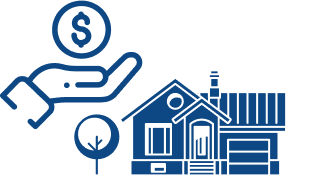What Are the Pros and Cons of Reverse Mortgage?
October 5th, 2023 / Author: Cesar GomezA reverse mortgage is not something that should be taken out lightly. Yes, it may provide a much-needed influx of cash, but it can also cause financial distress in the long term if not handled properly. Like with most loans you can take out, you should understand the pros and cons of reverse mortgage before making the decision.
And those pros and cons are highly dependent on the situation you or your parents are in. In this article, we will explain what a reverse mortgage is and how it works, and list the advantages and potential disadvantages. By the end, you will hopefully know enough about a reverse mortgage loan to make an informed decision.
What Is a Reverse Mortgage?
A reverse mortgage is a loan a homeowner can take out against the equity of their home. The borrower can choose to receive the funds as fixed monthly payments, a lump sum, or a line of credit. A person taking out a reverse mortgage loan does not have to make loan payments, unlike with regular loans.
The loan balance of a reverse mortgage is due after the borrower is deceased, moves away, or sells the home against which the loan was taken. Further, the loan needs to be structured in such a way that the borrower, their spouse, or their estate does not need to pay the difference if the loan balance becomes larger than the value of the property.
To simplify, a reverse mortgage loan can be considered a type of payment in advance on a home’s equity. The equity is converted into payments and the borrower keeps the title. The loan needs to be repaid only after the borrower dies, no longer lives in the home, or decides to sell the house.
Once the loan is due, the house may be sold to pay it off, but the amount that needs to be paid usually cannot exceed the value of the home. For example, this could happen if the market value of the home is lower at the time of sale than it was when the loan was taken out. Similarly, if the inheritors wish to keep the home, they wouldn’t pay more than the appraised value of the house.
Reverse Mortgage Types
There are 3 types of reverse mortgages, based on who issues the loan and what the purpose of the loan is:
1. Single-purpose reverse mortgage is a loan that is to be used only for a single purpose as specified by the lender. Examples of a single-purpose reverse mortgage would be taking it out to finance home improvements or pay property taxes. However, single-purpose reverse mortgages are not available everywhere and are only offered by some state agencies and non-profits.
2. Home Equity Conversion Mortgages (HECMs) are reverse mortgages that are federally insured and backed by the U.S. Department of Housing and Urban Development (HUD). They can be used for any purpose the borrower finds fitting.
3. Proprietary reverse mortgages are similar to HECMs in that they can be used for any purpose. However, they are private loans and backed by companies that issue them, thus, they are neither federally insured nor backed by HUD. This type of revere mortgage is usually more expensive than a HECM.
Who Is Eligible for a Reverse Mortgage Loan?
To qualify to take out a reverse mortgage, you need to meet several requirements:
- Be 62 years old or older. Own the home against which you will take out the reverse mortgage.
- Own enough home equity that the balance for the reverse mortgage loan will pay off (usually above 50%).
- The home must be your primary residence for the duration of the mortgage.
- Meet with a HUD-approved mortgage counselor (this is required for HECMs and by many companies issuing proprietary reverse mortgages).
How Is a Reverse Mortgage Different from a Home Equity Loan?
Reverse mortgages are similar to home equity loans, so people sometimes get them mixed up. However, there are two crucial differences:
1. The borrower does not need a good credit score or to have income to qualify for a reverse mortgage
2. The borrower does not make loan payments while alive or occupying the home as a primary residence.
How Does a Reverse Mortgage Function?
An eligible person can take out a reverse mortgage against their home and the home is now collateral for the mortgage. The lender makes payments to the borrower in the agreed-upon amount, but the borrower will also need to pay interest on the payments. Those interests are rolled into the loan balance and the borrower doesn’t pay them until the loan balance is due.
The borrower retains the title of the home. Over the duration of the mortgage, the borrower’s share of equity in the home decreases. When the borrower dies, moves away, or sells the home, the loan balance is due.
The home that was used as collateral is sold and the proceeds from the sale are used to pay off the debts – the loan principal, interest, insurance, and any additional fees. Any leftover proceeds go to the borrower or their inheritors. In some situations, the inheritors may pay off the mortgage and retain the home.
How High Can the Loan Be?
The amount of money that can be borrowed will depend on several factors, including the home’s market value, the share of equity in the home the borrower owns, and the type of reverse mortgage. It should also be noted that any outstanding debts relating to another loan, lien, or home equity line of credit must be repaid first with money received from a reverse mortgage.
Reverse Mortgage Advantages

Reverse mortgages can be practical solutions for seniors that need to pay medical expenses, meet the basic costs of living, or simply need a large sum of money to pay other, larger expenses. There are several benefits to reverse mortgages:
You Can Tap Into Your Equity and Continue Living in Your Home
Home equity is the largest source of wealth for seniors according to the National Reverse Mortgage Lenders Association. According to their latest report, homeowners 62 and older owned 8.05 trillion dollars in housing wealth in the fourth quarter of 2020.
A reverse mortgage is a way to tap into that wealth and meet living expenses. In addition, the borrower retains the title of the house and gets to continue living in it, without making loan payments for the duration of the mortgage.
So, a reverse mortgage allows you to turn your home equity into usable money while continuing to live in the home and you don’t need to make loan payments for the duration of the loan.
A Spouse May Stay in the Home After the Primary Lender is Deceased
If the primary borrower dies while still married, their spouse may continue living in the home, depending on the type of agreement that was signed. However, the spouse would still need to maintain the property and pay taxes, insurance, and regular fees.
It Can Prevent Foreclosure
One of the benefits of reverse mortgage is that you can use it to prevent foreclosure. The money received from the reverse mortgage loan would need to be used to repay the outstanding debts and you would be losing equity, but at least you could continue living in your house.
Lenders Can’t Ask For More Than the Home Is Worth
The sale price of the home may be less than what the total loan amount was worth. This could have happened if the real estate market crashes and your property gets devalued. Or, the borrower could have chosen to take regular monthly payments and lived much longer than expected, so the loan ends up larger than the worth of the house.
In either case, nobody is liable to pay more than the value of the home. So, even if the home is sold when the loan is due for less than the lender would have hoped, nobody can get stuck with additional debt.
Reverse Mortgage Disadvantages
However, while taking out a reverse mortgage might be a practical solution to some, it does come with several severe disadvantages.
You Are Losing Home Equity
One of the main negatives of reverse mortgage is that you are getting money by using the equity of your home. Thus, the more money you get over time, the lower the equity share you own and less can be inherited by your successors.
Paying the Interest
As with any loan, you are obligated to pay the interest. There are reverse mortgages with fixed rates, but they mostly apply only to lump-sum payments. Generally, the interest rates on reverse mortgages are variable. Variable interest rates increase over time, which means that you will be paying more the longer the loan lasts.
And as the interest is rolled into your loan balance which is to be paid from the home’s equity, you are losing more equity as time goes on.
Paying Fees and Insurance Premiums
Besides the loan principal and the interest, you may also need to pay an origination fee, an up-front insurance premium (2% of the home’s assessed value), ongoing premiums (0.5% of the amount borrowed annually), and service fees while the mortgage lasts. So even besides the interest, you are paying a significant amount of money in premiums and fees.
You Are Not Exempt from Regular Home Expenses
When you take out a reverse mortgage, you are still the owner of the home. That means that paying property taxes, for maintenance, utilities, homeowner’s insurance, HOA fees, etc. is your responsibility. If these payments are not made, the lender may ask you to repay the loan.
Are There Alternatives to Reverse Mortgages to Acquire Money?
Taking out a reverse mortgage is not a decision to be taken lightly. And now that you know the pros and cons of reverse mortgage, you may not find the terms favorable. But if you still need a way to turn your equity into money you can use, one option is to contact SleeveUp Homes. We will buy your house for cash so you won’t need to shop around for new loans.
And with SleeveUp Homes, you won’t be paying any realtor commission, closing or other hidden costs, or even have to invest in repairs – we buy homes as-is. You don’t need to make a decision right away. Request a no-obligation cash offer and see how our offer compares to any reverse mortgage option you find.
SELL
YOUR HOUSE
If you want to sell fast and are worried about how long the traditional process takes, and the commission and fees involved, consider working with SleeveUp Homes.





 view all blogs by this author
view all blogs by this author Zachariah Peterson (69 blogs)
Zachariah Peterson (69 blogs)